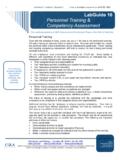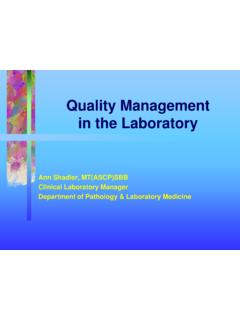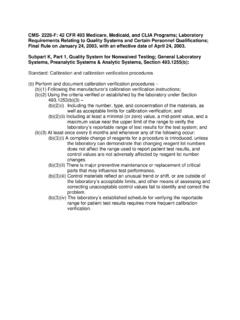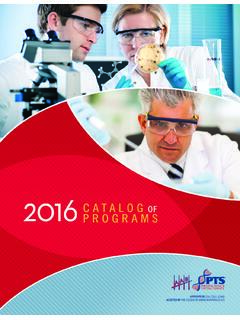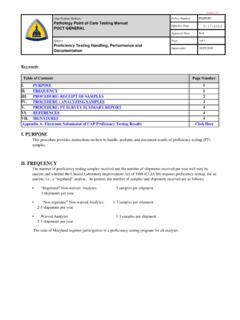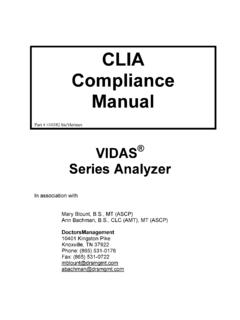Transcription of Writing Quality Assurance Plans Conducting …
1 cola Version 1, December 2000 1 of 6 Writing Quality Assurance Plans & Conducting Written Quality Assurance Reviews An effective Quality Assurance (QA) plan addresses the entire laboratory process, from the time a patient or sample arrives in your facility, to the moment results are recorded on patient charts and reported to the appropriate health care provider. The steps listed in this packet will assist you in Writing and implementing a QA plan . Writing Quality Assurance Plans When Writing a QA plan , it should begin with your laboratory s Purpose and Goal for QA. For each element to be reviewed always indicate what will be reviewed, when reviews will be conducted, how the review will be conducted, and an acceptable threshold. QA Plans should also include a provision to follow-up on corrective actions taken. By implementing routine follow-up procedures you can ensure problems are corrected, and if not, take further action to resolve the problem.
2 A calendar should be established identifying when system reviews are to be performed. Every system in the laboratory should be thoroughly evaluated over the course of one year. See the sample pages for examples of a QA plan , completed QA review, and annual calendar of reviews. Elements Appropriate for QA Review There are three phases of laboratory testing. Under each testing phase the bold items listed are the elements (items to review) that should be addressed in your written QA plan . ? Pre-analytical (before testing) phase 1. Personnel training and evaluation Ensure each employee s personnel folder includes: a. Documentation of an evaluation every six months during the first year of employment and annually thereafter. b. Continuing education (must be specifically documented). c. Proof of education. d. Annual safety and OSHA training. e. Evidence of Hepatitis B vaccine options.
3 2. Test tracking (requisitions) Ensure the following are noted on each requisition: a. Name and address of healthcare provider ordering tests. b. Patient name or identifier. c. Date and time of collection. d. Pertinent patient information (sex, date of birth, diagnosis, etc). 3. Specimen handling, collection, and labeling Ensure the following: a. The unique patient identifier used when labeling the specimen remains with the sample throughout the testing process. b. Specimens are collected, handled, stored, and preserved as appropriate. c. A written mechanism is in place to inform patients of special requirements for testing ( fasting, 24-hour urine collection). d. Written instructions are in place to identify unacceptable samples and if necessary, to contact the patient for recollection. e. All staff are following universal precautions. Writing Quality Assurance Plans & Conducting Written Quality Assurance Reviews cola Version 1, December 2000 2 of 6 ?
4 Analytical (during testing) phase 1. Instruments: a. Verify calibrations are performed at frequency indicated by the manufacturer or every six months, whichever is more frequent. b. Ensure daily, weekly, and monthly maintenance is performed and documented as indicated by manufacturer instructions. c. Check Quality control (QC) results, graphs, and corrective actions by ensuring that: ? QC is performed according to written policies and procedures. ? QC is performed at the proper frequency ( , Hematology QC is required every eight hours). ? QC graphs are reviewed at least weekly for shifts and trends. ? Corrective actions are documented for any out-of-range results. d. Verify patient results are not reported until QC is within expected ranges. e. Verify laboratory Director or Technical Consultant has reviewed and signed QC charts monthly. 2. Check instrument or kit performance specifications: a. Evaluate corrective actions taken when instruments or kits do not meet performance specifications.
5 3. Proficiency testing (PT) and split sample testing: a. Verify PT and/or split sampling is performed in accordance with CLIA guidelines. (Refer to cola Lab Guides 8 and 9 in your cola accreditation manual ). b. Ensure PT is performed in the same manner as patient testing. c. Ensure a review of graded results is conducted and documented. d. Verify unsuccessful or unsatisfactory PT events are investigated and corrective actions taken. Document findings and actions. e. If two methods are used to perform the same test, evaluate the difference between the two methods at least twice per year. ( , spun hematocrit versus Coulter hematology analyzer). 4. Check reference ranges are appropriate for patient population: a. Perform periodic reviews of reference ranges for patient population. ? Post-analytical (after testing) phase 1. Result reporting - Verify reports contain the following information: a. Name of test. b. Results, units of measure, and normal ranges.
6 C. Testing person is identified. d. Patient name. e. laboratory name and address. 2. Records: a. Verify lab records and final results on patient chart are the same. b. Inspect unacceptable specimen rejection logs. c. Ensure records are maintained for at least two years. (Immunohematology five years and pathology testing 10 years.) 3. Verify procedure for correction of laboratory results is established and followed: a. Ensure ordering physician is notified immediately. b. Ensure a corrected report is provided. c. Ensure both original and corrected copies are retained for 2 years (Immunohematology five years). Writing Quality Assurance Plans & Conducting Written Quality Assurance Reviews cola Version 1, December 2000 3 of 6 4. Ensure critical (panic) value procedures are followed and documented: a. Verify date and time healthcare provider is notified. b. Verify patient name and critical values are documented.
7 C. Verify person who notified healthcare provider is documented. 5. Turn-around-time evaluation: a. Verify results are reported to the healthcare provider in a clinically useful time. b. Verify STAT and critical values are reported within specified turn-around-time. c. Verify documentation of reporting of STAT and critical values. d. Verify turn-around-times for samples sent to reference laboratories are acceptable. 6. Communication and complaints: a. Ensure communication is evaluated to avoid breakdowns between laboratory staff, physicians and other personnel. b. Verify communication breakdown is documented along with possible solutions. c. Ensure complaints are promptly recorded and evaluated between staff, patients, and other health care providers. d. Ensure remedial action is documented for all valid complaints. There are many other elements for review that your laboratory may want to include in the plan ( , overall QA plan , policy/procedure manual , vendor/reference lab relationships).
8 Conducting Written Quality Assurance Reviews QA is an ongoing process, not just a response to problems. There are two situations that prompt a QA review: ? Routine scheduled evaluations of specific elements. ? Responses to identified laboratory problems or complaints that require immediate attention. The first step in Conducting a QA review should be to accumulate supporting data. Developing checklists specific for each element of review is a convenient way to accumulate the supporting data. Your laboratory should develop checklists specifically tailored to your needs. Upon review, if a problem is identified, documentation should include: ? supporting data ? description of the problem ? corrective action taken ? date corrective action taken ? date of review of corrections (follow-up) ? results of corrective actions ? who conducted the review Prepare a yearly calendar and specify which elements will be reviewed each month.
9 The Quality Assurance Review Form at the end of this packet may be used in documenting the QA review of various aspects of your laboratory . It contains headings to record all necessary information. The format can be modified to accommodate your laboratory s QA plan . Reference: Quality Assurance in the laboratory , cola Lab Guide 70, revised 5/99. Writing Quality Assurance Plans & Conducting Written Quality Assurance Reviews cola Version 1, December 2000 4 of 6 Sample Written Quality Assurance (QA) plan Only two elements are detailed in this example. Your QA plan should address all elements previously noted. ( cola criteria questions 279-299 address QA. Refer to your cola accreditation manual ). Additional topics for review may be added as appropriate for your laboratory . Purpose: The purpose of our QA program is to improve the reliability, efficiency, and Quality of laboratory services.
10 Goals: The Goals of our QA program are to: ? Improve the overall Quality and efficiency of the laboratory service. ? Evaluate the effectiveness of the laboratory s policies and procedures. ? Identify problems and make corrections. ? Assure accurate, reliable and prompt performance of tests and reporting results. Implementation: Our QA program will be implemented as indicated: 1. Personnel Training and Evaluation will be reviewed annually. All employee files will be screened for evidence of performance reviews, proof of education, continuing education, OSHA training, safety training, and Hepatitis B vaccine options. Should omissions be found, corrective actions will be developed and implemented. Follow up reviews shall be conducted in three months to ensure that all required documentation is in place. 100 percent compliance is expected. 2. Test Tracking - Requisitions will be reviewed quarterly by randomly selecting 10 requisitions.
